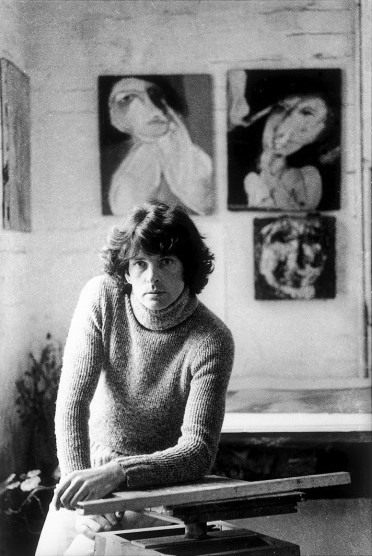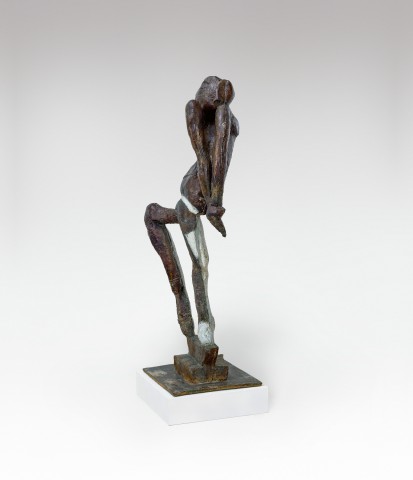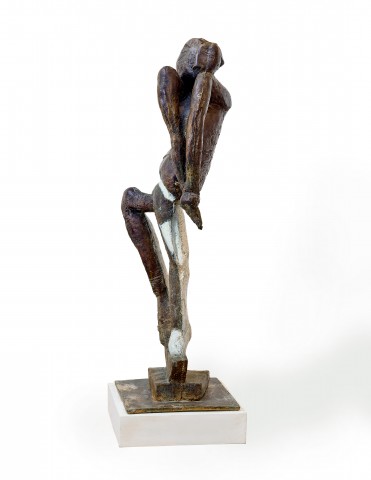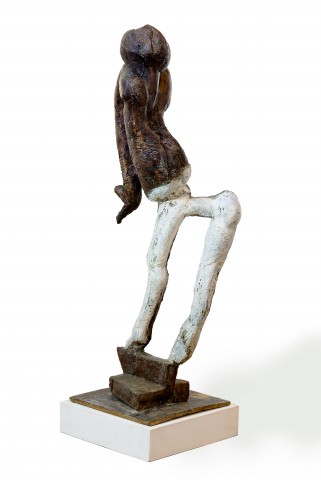TRAPEZE, 1965
GEORGE BALDESSIN
bronze and synthetic polymer paint
178.0 x 63.5 x 63.0 cm
stamped and numbered on base: Victorian College of the Arts Foundry 1/4
Private collection, Melbourne
Menzies, Sydney, 21 March 2013, lot 20
John Barnes, Melbourne, acquired from the above
The Estate of John Barnes, Melbourne
New Trends in Australian Art, Rudy Komon Gallery, Sydney, June 1965, cat. 1 (another example)
George Baldessin: Sculpture and Etchings, National Gallery of Victoria, Melbourne, 8 August – 18 September 1983, cat. 108 (another example)
Baldessin/Whiteley: Parallel Visions, The Ian Potter Centre: NGV Australia, Melbourne, 31 August 2018 – 28 January 2019 (another example)
Lindsay, R., and Holloway, M. J., George Baldessin: Sculpture and Etchings, National Gallery of Victoria, Melbourne, 1983, cat. 108, pp. 118, 119 (illus., another example)
Edquist, H., George Baldessin - Paradox & Persuasion, Australian Galleries, Melbourne, 2009, pp. 52 (illus., another example), 53, 246
Grishin, S., Baldessin/Whiteley: Parallel Visions, The Ian Potter Centre: NGV Australia, Melbourne, 2018, p. 191
Another edition of this sculpture is held in the collection of the National Gallery of Australia, Canberra
George Baldessin in his Winfield Building studio, Melbourne 1975

|
George Baldessin in his Winfield Building studio, Melbourne 1975
photographer unknown
Australian Galleries, Melbourne
|
Despite the fact that George Baldessin never revealed his immigrant roots to his artist colleagues and friends, when he decided to further extend his art education, he chose his native Italy, studying at the Brera Academy in Milan in 1963. The aspiring artist had worked his passage as a waiter on a ship to London, and before arriving in Italy, attended the printmaking department at the Chelsea School of Art, following in the footsteps of former student Fred Williams. Baldessin was determined to be an artist and was committed to honing his skills. As Patrick McCaughey stated after the artist’s untimely death: ‘George Baldessin was the example of what it meant to be an artist. His singlemindedness, his capacity for sustained hard work and the ambition of his imagination were rightly taken as exemplary ways for the artist to follow.’1
At the Brera Academy, Baldessin studied under sculptor Mario Marini and his assistant Alik Cavalieri. While it was an article on Marini that first compelled Baldessin to apply,2 in the end it was the haunting, surreal work of Cavalieri, and his expertise in bronze casting, that was to have the greatest influence.3 Baldessin’s own unique language across printmaking and sculpture was to soon display the sense of alienation and existential angst that was a hallmark of Cavalieri’s practice. After returning to Melbourne in 1963, Baldessin held his first solo exhibition at the Argus Gallery, Melbourne in 1964 and was included in the seminal Mildura Sculpture Triennial that same year. On the strength of these achievements, he was invited to join the stable of Sydney art dealer Rudy Komon, holding his first exhibition at the gallery in 1965.
The artist’s fascination with circus performers began with his first etchings in 1963, which were inspired by the etchings that Fred Williams had made of London’s music halls in 1955 – 56.4 While performers featured in Baldessin’s prints across 1963 and 1964, Trapeze, 1965 also provides an early indication of his preoccupation with the human body and particularly the female form, her movement often suspended in a moment of contortion heightened by its frozen state. With her extended hip (or buttock?) and leg, elongated arms and entwined hands, the body of Baldessin’s trapeze artist challenges the limits of human anatomy, as if the death-defying and graceful movements she would make in mid-air have crashed to the ground, only to be gathered up and put together in the wrong configuration. The addition of white paint to the work’s bronze surface only adds to this sense of distortion, perhaps signalling a pair of tights, but only part of. While the figure’s form is drawn from the sense of magic that experience of the trapeze inspires, the performer’s barely rendered face and pitted and scarred body imbues this sense of joy with an air of melancholy.
1. McCaughey, P., ‘Preface’ in Lindsay, R. & Holloway, M.J., George Baldessin: Sculpture and Etchings. A Memorial Exhibition, National Gallery of Victoria, Melbourne, 1983, p. 8
2. Baldessin read the article on Marini in Art and America in the library of the Chelsea School of Art, see Lindsay, R., ‘Biographical Notes’ in ibid., p. 10
3. Holloway, M.J., ‘Venus in Sackcloth: Eroticism and Ritual in the Work of George Baldessin’, ibid., p. 29
4. Williams proofed and printed these works at the RMIT printmaking studio while Baldessin was a student. The Thursday evening and later, Friday classes were reserved for already practicing artists and included the likes of Williams, John Brack and Leonard French, among others.
KELLY GELLATLY



